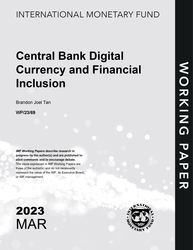
Central Bank Digital Currency and Financial Inclusion
Central Bank Digital Currency and Financial Inclusion
READ MORE...
Volume/Issue:
Volume 2023
Issue 069
Publication date: March 2023
ISBN: 9798400238277
$20.00
Add to Cart by clicking price of the language and format you'd like to purchase
Available Languages and Formats
| English |
Prices in red indicate formats that are not yet available but are forthcoming.
Topics covered in this book
This title contains information about the following subjects.
Click on a subject if you would like to see other titles with the same subjects.
Banks and Banking , Finance , Economics- Macroeconomics , Economics / General , CBDC , Financial Inclusion , Digital currency , CBDC issuance , credit-risk information asymmetry , CBDC data , CBDC model , CBDC wallet , Central Bank digital currencies , Commercial banks , Deposit rates , Loans , Global
Also of interest
Summary
In this paper, we develop a model incorporating the impact of financial inclusion to study the implications of introducing a retail central bank digital currency (CBDC). CBDCs in developing countries (unlike in advanced countries) have the potential to bank large unbanked populations and boost financial inclusion which can increase overall lending and reduce bank disintermediation risks. Our model captures two key channels. First, CBDC issuance can increase bank deposits from the previously unbanked by incentivizing the opening of bank accounts for access to CBDC wallets (offsetting potential flows from deposits to CBDCs among those already banked). Second, data from CBDC usage allows for the building of credit to reduce credit-risk information asymmetry in lending. We find that CBDC can increase overall lending if (1) bank deposit liquidity risk is low, (2) the size and relative wealth of the previously unbanked population is large, and (3) CBDC is valuable to households as a means of payment or for credit-building. CBDC can still be optimal for household welfare even when overall lending decreases as households benefit from the value of using CBDC for payments, CBDC provides an alternative "safe" savings vehicle, and CBDC generates greater surplus in lending by reducing credit-risk information asymmetry. Most countries are considering a "two-tier" CBDC model, where central banks issue CBDC to commercial banks which in turn distribute them to consumers. If non-bank payment system providers can distribute CBDC, fewer funds will flow into deposit accounts from the unbanked because a bank account is no longer needed to access CBDC. If CBDC data is shareable with banks, those without bank accounts can still build credit and access lower interest rate loans. This design is optimal for welfare if the gains from greater access to CBDC outweigh the contraction in lending.
Copyright © 2010 - 2025
Powered by:
AIDC



